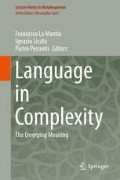Abstract
Classifying the information content of neural spike trains, an uncertainty relation emerges between the bit size of a word and its duration. This uncertainty is ruled by a quantum constant whose numerical value has nothing to do with Planck’s constant.
Access this chapter
Tax calculation will be finalised at checkout
Purchases are for personal use only
References
Aerts, D. (2009). Quantum structure in cognition. Journal of Mathematical Psychology, 53(5), 314–348.
Aerts, D., & Aerts, S. (1995). Applications of quantum statistics in psychological studies of decision processes. Foundations of Science, 1, 85–97.
Arecchi, F. T. (2003). Chaotic neuron dynamics, synchronization and feature binding: Quantum aspects TH. Mind and Matter, 1, 15–43.
Arecchi, F. T. (2004a). Chaotic neuron dynamics, synchronization and feature bindingc. Physica, A, 338, 218–237.
Arecchi, F. T. (2004b). Caos e complessità nel viventeH. Pavia: IUSS Press.
Arecchi, F. T. (2007). Complexity, information loss and model building: From neuro- to cognitive dynamics. In SPIE Noise and Fluctuation in Biological, Biophysical, and Biomedical Systems (pp. 6602–36).
Arecchi, F. T. (2012). Fenomenologia della coscienza: dall’apprensione al giudizio. in A. Ales Bello (Ed.) …e la coscienza?Fenomenologia, psico-patologia, neuroscienze (pp. 841–875). Laterza, Bari: Patrizia Manganaro.
Arecchi, F. T. (2013). La coscienza e il linguaggio: perché e come. Congetture quantistiche. In L. Urbani Ulivi (Ed.), Strutture di mondo, Vol. II, (pp. 199–226). Bologna: il Mulino.
Baars, B. J. (1988). A cognitive theory of consciousness. Cambridge: Cambridge University Press.
Busemeyer, J. R., & Bruza, P. D. (2012). Quantum models of cognition and decision. Cambridge: Cambridge University Press.
Dehaene, S., Sergent, C., & Changeux, J.-P. (2003). A neuronal network model linking subjective reports and objective physiological data during conscious perception. Proceedings of the National Academy of Science (USA), 100(14), 8520–8525.
Feynman, R. (1966), The feynman lectures on physics, Vol. III, Chapter 1.
Freeman, W., & Vitiello, G. (2006). Nonlinear brain dynamics as macroscopic manifestation of underlying many-body dynamics. Physics of Life Reviews, 3, 93–118.
Grossberg, S. (1995). The attentive brain. American Scientist, 83, 438–449.
Grover, L. K. (2001). From Schrödinger’s equation to quantum search algorithm. American Journal of Physics, 69, 769–777.
Hagan S., Hameroff S. R., & Tuszynski J. A. (2002). Quantum computation in brain microtubules: Decoherence and biological feasibility. Physical Review, 65(6).
Humboldt, W. (1836). On language: On the diversity of human language construction and its influence on the mental development of the human species (P. Heath, Trans.). Cambridge: Cambridge University Press, 1988.
Jensen, O., & Colgin, L. L. (2007). Cross-frequency coupling between neuronal oscillations. Trends in Cognitive Science, 11, 267–269.
Khrennikov, A. Y. (2010). Ubiquitous quantum structure: From psychology to finance. Berlin: Springer.
Koch, C., & Hepp, K. (2006). Quantum mechanics in the brain. Nature, 440, 611.
Penrose, R. (1994). Shadows of the mind. New York: Oxford University Press.
Pöppel, E. (1997). A hierarchical model of temporal perception. Trends in Cognitive Sciences, 1, 56–61.
Pöppel, E. (2004). Lost in time: A historical frame, elementary processing units and the 3-second window. Acta Neurobiologiae Experimentalis, 64, 295–301.
Rieke, F., Warland, D., de Ruyter van Steveninck, R., & Bialek, W. (1996). Spikes: Exploring the neural code. Cambridge: MIT Press.
Rodriguez, E., George, N., Lachaux, J. P., Martinerie, J., Renault, B., & Varela, F. (1999). Perception’s shadow: Long-distance synchronization in the human brain. Nature, 397, 340–343.
Ronchi, V. (1957). Optics. The science of vision. New York: Dover Publications.
Singer, W., & Gray, C. M. (1995). Visual feature integration and the temporal correlation hypothesis. Annual Reviews of Neuroscience, 18, 555–586.
Tegmark, M. (2000). The importance of quantum decoherence in brain processes. Physical Review, E 61, 4194–4206.
Turing, A. (1950). Computing machinery and intelligence. Mind, 59, 433–460.
Vitiello, G. (2001). My double unveiled. Amsterdam: John Benjamins.
Author information
Authors and Affiliations
Corresponding author
Editor information
Editors and Affiliations
Rights and permissions
Copyright information
© 2017 Springer International Publishing Switzerland
About this chapter
Cite this chapter
Arecchi, F.T. (2017). Fiat Lux Versus Fiat Lumen: Quantum Effects in Linguistic Operations. In: La Mantia, F., Licata, I., Perconti, P. (eds) Language in Complexity. Lecture Notes in Morphogenesis. Springer, Cham. https://doi.org/10.1007/978-3-319-29483-4_8
Download citation
DOI: https://doi.org/10.1007/978-3-319-29483-4_8
Published:
Publisher Name: Springer, Cham
Print ISBN: 978-3-319-29481-0
Online ISBN: 978-3-319-29483-4
eBook Packages: EngineeringEngineering (R0)

